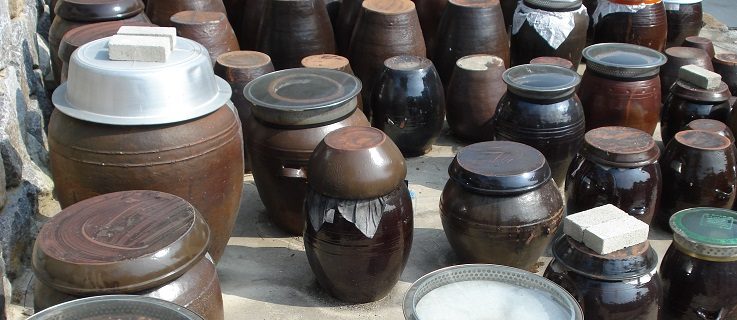The ancient culinary craft of fermentation is bubbling up once again. In a climate-constrained future, it could preserve both food and cultural diversity.
“To ferment your food,” declares American food journalist Michael Pollan, “is to lodge an eloquent protest—of the senses—against the homogenizations of flavors and food experiences. It’s a way of engaging with the world... a declaration of independence.”
That’s because this revival is not just about learning how to prep and preserve cabbage: it’s also a way for people to get their hands (literally) on another social narrative and activate a different relationship with life. It runs counter to an industrialized and passive consumer lifestyle. Fermentation requires time and intuition and participation in a transformative process where no two sauerkrauts will turn out the same. And it can bring people together in practical and surprising ways.
A Fermenting Revivalist
Some of the fermentation revival is due to the bold maverick moves of Sandor Ellix Katz, a self-taught U.S. fermenter based in rural Tennessee whose online demonstrations and guide books have grabbed the imaginations of cooks and homesteaders everywhere. In his latest book, the encyclopaedic The Art of Fermentation, he documents fermentation practices around the world, capturing modern and indigenous voices, discussing everything from molecular biology to cultural history, from philosophy to health benefits.
Before refrigeration came into our houses and global supply chains, most of our winter stores were salted, pickled, and dried. Many of the strong compelling flavors found in European delicatessens come via fermentation: cheese, salami, gherkins, vinegar, olives. Likewise the mainstays of Asian cuisine—soy, miso, and tempeh—and the whole of the world’s drinks cabinet, including everyday luxuries such as coffee and chocolate.
If you were wary of venturing into this unknown territory alone, you could not hope for a more enthralling guide than Katz: “My advice is to reject the cult of expertise. Do not be afraid. You can do it yourself.” There is no recorded case, he assures us, of poisoning from fermented vegetables.
This is because fermentation is not just another culinary fashion. In the same way that baking bread or growing vegetables helps decouple us from the industrial food system, remembering the skills of preservation puts the art of production back into our own hands and brings the meaning and joy of eating back into everyday life.
Sharing the Heritage
Fermentation is above all a creative process. Eva Bakkeslett, artist and "gentle activist" from north Norway, teaches Living Culture workshops that inspire people to reconnect with the traditional skills of making kefir, yogurt, and sourdough bread. “I explore fermentation in my art practice because it reveals how a living cultural process works and shows the key ingredients we need to cultivate sustainable cultures for the future: time, conditions (warmth), nurturing and sharing, good quality materials, and a touch of magic,” explains Bakkeslett. “It makes us aware that living on Earth entails a seamless sharing between species and makes it hard to define the self as an isolated entity.”
Her workshops are not just about food: they are places for social fermentation, where conversations and new perspectives can emerge and the generous, self-organizing nature of sharing cultures, skills, knowledge, and stories can thrive.
A Healthy Practice
Fermenting as a preservation technique has evolved, like our digestion, over thousands of years. Today one of its main attractions is as a way to maintain and restore good health, often impaired by a fast, factory-processed diet. Full of enzymes and beneficial flora, fermented foods help heal the gut wall and chase off harmful invaders. The intestine, as Sandor Katz reminds us, is the largest part of the body’s immune system.
Where to start? One of the easiest ways is kvass, a fermented drink made with beets, which is an excellent blood tonic and liver cleanser. All you need is a large jar into which you pour two liters of filtered water. Add three medium-sized organic beetroots, peeled and chopped, together with 1 tablespoon of sea salt and a quarter of a cup of whey (or you can omit the whey and double the salt). Leave out for two to three days. Transfer the strained liquid to the fridge, keeping the beets for another batch. Start each day with a four-ounce glass.
Rediscovering these cultures is beneficial not just for people but for the planet as well. As climate change intensifies, industrial countries are being challenged to reduce their fossil-fuel consumption. The "cold chains" of the global food system, which include field precooling stations, slaughterhouses, distribution centers, trucks, supermarkets, and domestic refrigerators, all require high amounts of energy. Today this modern method of preservation is responsible for 15 percent of global electricity consumption, and these emissions will most likely keep rising.
In China, where fermented food has its ancestral roots, refrigeration is rapidly transforming a diverse vernacular food culture into the industrial model found in richer countries. Fermentation—which uses no energy and is entirely natural—is one practical way we can reverse the trend, reclaiming both our heritage from the past and the climate for the future.
Time to get out the pickle jar!
